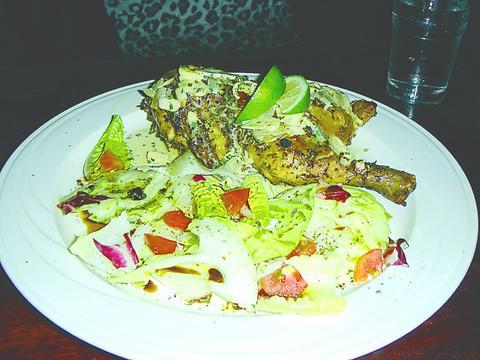It could be considered incongruous, eating a slice of pizza while sipping a thick yogurt drink called a lassi. At a time when fusion cooking, or mix and match, is all the rage, Peacock in the Shida section of Taipei is blazing a trail for local foodies.
Peacock, which opened in late March, is the product of two college classmates and one of their brothers, who grew weary of the daily grind and wanted instead to try their hand at something more entrepreneurial.

PHOTO: CHRIS FUCHS, TAIPEI TIMES
It's neither a restaurant nor a bar, neither a cafe nor lounge. Rather, Peacock prides itself on not being pigeonholed, as evidenced by its food, spirit selection and decor.
"The atmosphere is very laid-back here," said Barbie Chang, describing the dimly lit, dark-wood interior design of Peacock. "If people see attractive lighting and colorful decorations, they'll want to come."
Chang said they chose the name Peacock because the brightly colored male bird, a Hindu god, represents good luck in India. Indeed, a good deal of Peacock's influence is drawn from Indian culture. Before opening the place in March, Chang and another co-owner, Angel Guo, traveled to India and enrolled in cooking classes for a couple of weeks.
Besides bringing back traditional Indian knickknacks, they also returned with a recipe for a yogurt-based beverage called lassi. "It especially helps with digestion," Guo said.
Peacock's lassi had the consistency of a thick shake and tasted like yogurt, which is just as well, because that's what it's made of. To Peacock's credit, they make the yogurt fresh from milk and cultures.
Pizza is found relatively easily in Taiwan, but it's often inedible. Peacock's pizza uses a paper-thin crust and comes in a number of varieties: plain, seafood, vegetable, or with fruit.
The Margherita, at NT$250, is the no-frills choice made from mozzarella and tomato sauce. Fortunately, the pizza had none of that pre-frozen-heated-on-the-spot taste associated with commerical chains. A Belgian beer like Chimay, dark in color and nutty in flavor, complements the Margherita.
Guo said they planned to expand the menu's selections after returning from another trip to India in November. Currently, Peacock succeeds without rigidly defining itself and is bound to offer something to please most people's pallettes.

Most heroes are remembered for the battles they fought. Taiwan’s Black Bat Squadron is remembered for flying into Chinese airspace 838 times between 1953 and 1967, and for the 148 men whose sacrifice bought the intelligence that kept Taiwan secure. Two-thirds of the squadron died carrying out missions most people wouldn’t learn about for another 40 years. The squadron lost 15 aircraft and 148 crew members over those 14 years, making it the deadliest unit in Taiwan’s military history by casualty rate. They flew at night, often at low altitudes, straight into some of the most heavily defended airspace in Asia.

Taiwan’s democracy is at risk. Be very alarmed. This is not a drill. The current constitutional crisis progressed slowly, then suddenly. Political tensions, partisan hostility and emotions are all running high right when cool heads and calm negotiation are most needed. Oxford defines brinkmanship as: “The art or practice of pursuing a dangerous policy to the limits of safety before stopping, especially in politics.” It says the term comes from a quote from a 1956 Cold War interview with then-American Secretary of State John Foster Dulles, when he said: ‘The ability to get to the verge without getting into the war is

Beijing’s ironic, abusive tantrums aimed at Japan since Japanese Prime Minister Sanae Takaichi publicly stated that a Taiwan contingency would be an existential crisis for Japan, have revealed for all the world to see that the People’s Republic of China (PRC) lusts after Okinawa. We all owe Takaichi a debt of thanks for getting the PRC to make that public. The PRC and its netizens, taking their cue from the Chinese Communist Party (CCP), are presenting Okinawa by mirroring the claims about Taiwan. Official PRC propaganda organs began to wax lyrical about Okinawa’s “unsettled status” beginning last month. A Global

Like much in the world today, theater has experienced major disruptions over the six years since COVID-19. The pandemic, the war in Ukraine and social media have created a new normal of geopolitical and information uncertainty, and the performing arts are not immune to these effects. “Ten years ago people wanted to come to the theater to engage with important issues, but now the Internet allows them to engage with those issues powerfully and immediately,” said Faith Tan, programming director of the Esplanade in Singapore, speaking last week in Japan. “One reaction to unpredictability has been a renewed emphasis on